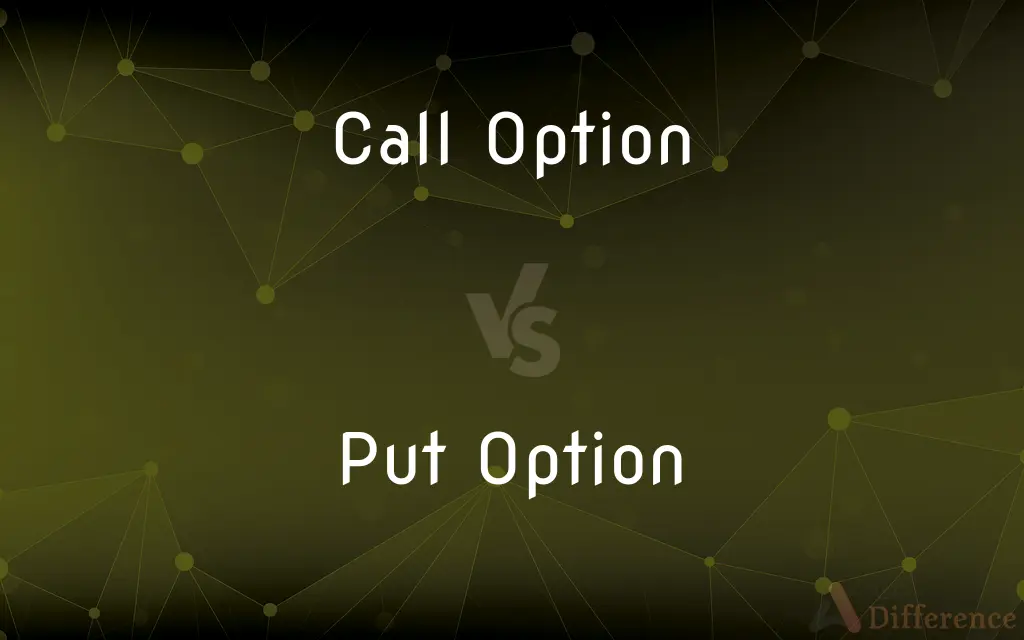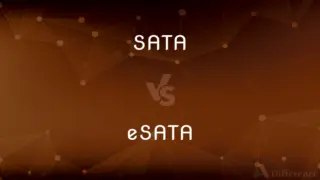Call Option vs. Put Option — What's the Difference?
By Tayyaba Rehman — Published on January 18, 2024
A Call Option gives the right to buy an asset at a set price, while a Put Option gives the right to sell an asset at a set price.

Difference Between Call Option and Put Option
Table of Contents
ADVERTISEMENT
Key Differences
A Call Option is a financial contract that gives the option buyer the right, but not the obligation, to purchase a specific asset (like a stock) at a predetermined price (strike price) within a set time period. In contrast, a Put Option grants the buyer the right to sell a specific asset at the strike price within the same defined timeframe.
The value of a Call Option increases when the price of the underlying asset rises above the strike price, making it beneficial for investors who anticipate a market upswing. On the other hand, a Put Option becomes more valuable when the price of the underlying asset falls below the strike price, suitable for those expecting a market downturn.
Call Option buyers aim to leverage market gains and are often bullish about the asset's future value, while Put Option buyers are typically bearish, seeking to profit or hedge against declines in the asset's value.
The risk for Call Option buyers is limited to the premium paid for the option, and they benefit from market rises without the need to invest the full amount in the asset. Conversely, Put Option buyers can protect their investments or speculate on market declines with a risk limited to the option's premium.
In essence, Call Options are financial tools for those optimistic about an asset's future, offering a way to capitalize on upward price movements. Put Options, conversely, provide a strategy for investors to manage or benefit from downward trends in the market.
ADVERTISEMENT
Comparison Chart
Right Granted
To buy an asset at a set price
To sell an asset at a set price
Market Outlook
Bullish, expecting a price rise
Bearish, expecting a price fall
Risk
Limited to the premium paid
Limited to the premium paid
Benefit
Profit from rising prices
Profit from or hedge against falling prices
Suitable For
Investors anticipating market upswing
Investors expecting market downturn
Compare with Definitions
Call Option
A financial contract allowing the purchase of an asset at a specific price.
He bought a call option in anticipation of the stock's value increasing.
Put Option
A contract granting the right to sell an asset at a predetermined price.
He purchased a put option as a hedge against potential stock price declines.
Call Option
Beneficial when the underlying asset's price rises above the strike price.
Her call options gained value as the market trended upward.
Put Option
Bearish investment strategy with limited risk.
Investors often buy put options when they expect market downturns.
Call Option
Offers the right to buy without the obligation.
The call option gave her the flexibility to buy the shares if prices rose.
Put Option
Provides a way to sell assets at a set price, regardless of market decline.
Her put options safeguarded her portfolio during the market dip.
Call Option
Used by investors to leverage gains from rising asset prices.
The call option became profitable as the market price exceeded the strike price.
Put Option
Valuable when the market price falls below the strike price.
As the market fell, the value of his put options rose.
Call Option
Bullish investment strategy with limited risk.
He used call options to speculate on the tech stock's future growth.
Put Option
Used to profit from or protect against falling asset prices.
The put option became valuable when the stock prices plummeted.
Common Curiosities
How does a put option work?
It allows the holder to sell a specific asset at a predetermined price within a set timeframe.
When is a call option profitable?
When the market price of the underlying asset rises above the strike price.
Can you lose money on a call option?
Yes, the risk is limited to the premium paid for the option.
Why buy a put option?
To speculate on a price fall or protect investments against market downturns.
What is a call option in simple terms?
A financial contract that gives the right to buy a specific asset at a set price within a certain period.
What happens when a put option expires?
If it's out of the money (market price above strike price), it becomes worthless.
What is the risk in selling a put option?
If the market price falls significantly, the seller may incur substantial losses.
How is the strike price set for a put option?
It's agreed upon by the buyer and seller at the time of the option contract's creation.
Are put options a good investment?
They can be, especially for hedging risks or if you expect a market decline.
What is the main use of a put option?
To profit from or hedge against a decline in the asset's market price.
Is buying a call option bullish or bearish?
Bullish, as it bets on an increase in the asset's price.
How much can you make from a call option?
Profit potential is theoretically unlimited as the market price of the asset can rise indefinitely.
What determines the price of a call option?
Factors like the underlying asset's price, time to expiration, and volatility.
Can you exercise a call option before expiration?
Yes, if it’s an American-style option.
Is a call option a derivative?
Yes, both call and put options are types of derivative instruments.
Share Your Discovery

Previous Comparison
SATA vs. eSATA
Next Comparison
Lufthansa vs. Qatar AirwaysAuthor Spotlight
Written by
Tayyaba RehmanTayyaba Rehman is a distinguished writer, currently serving as a primary contributor to askdifference.com. As a researcher in semantics and etymology, Tayyaba's passion for the complexity of languages and their distinctions has found a perfect home on the platform. Tayyaba delves into the intricacies of language, distinguishing between commonly confused words and phrases, thereby providing clarity for readers worldwide.














































